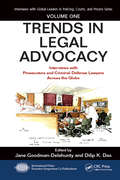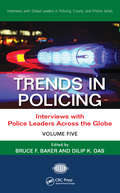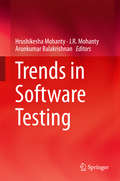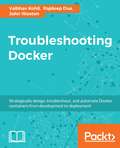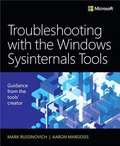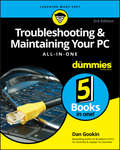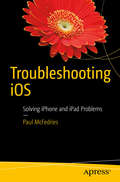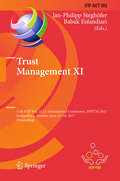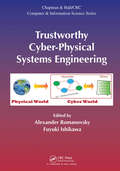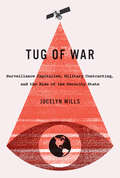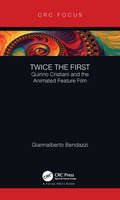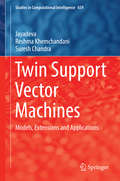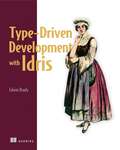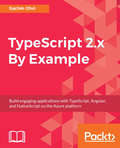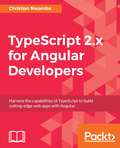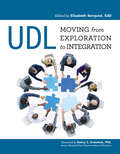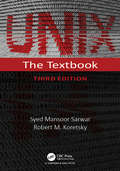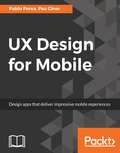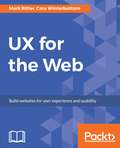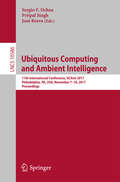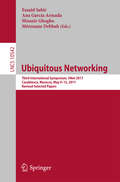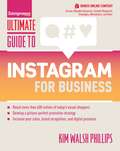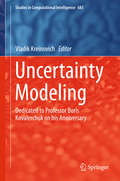- Table View
- List View
Trends in Legal Advocacy: Interviews with Prosecutors and Criminal Defense Lawyers Across the Globe, Volume One (Interviews with Global Leaders in Policing, Courts, and Prisons)
by Jane Goodman-Delahunty and Dilip K. DasA new installment of the series of Interviews with Global Leaders in Policing, Courts, and Prisons, this book expands upon the criminal justice coverage of earlier volumes, offering the voices of 14 lawyers from 13 diverse locales, including countries in Africa, North America, South America, Europe, and the Asia-Pacific region. This book is intended for students and others focusing on law and legal studies, policing, psychology and law, criminology, justice studies, public policy, and for all those interested in the front lines of legal change around the world. Featuring versatile chapters perfect for individual use or as part of a collection, this volume offers a personal approach to the legal world for students and experienced professionals.
Trends in Policing: Interviews with Police Leaders Across the Globe, Volume Five (Interviews with Global Leaders in Policing, Courts, and Prisons #1)
by Dilip K. Das Bruce F. BakerTrends in Policing: Interviews with Police Leaders Across the Globe, Volume Five, is based on the premise that police officials have a wealth of experience that can make significant contributions to our understanding of the prospects and problems of policing today. Each chapter consists of an interview with a policing leader that explores their understanding of policing developments and current challenges in their countries and internationally, and examines how they evaluate or interpret these developments.
Trends in Software Testing
by Hrushikesha Mohanty J. R. Mohanty Arunkumar BalakrishnanThis book is focused on the advancements in the field of software testing and the innovative practices that the industry is adopting. Considering the widely varied nature of software testing, the book addresses contemporary aspects that are important for both academia and industry. There are dedicated chapters on seamless high-efficiency frameworks, automation on regression testing, software by search, and system evolution management. There are a host of mathematical models that are promising for software quality improvement by model-based testing. There are three chapters addressing this concern. Students and researchers in particular will find these chapters useful for their mathematical strength and rigor. Other topics covered include uncertainty in testing, software security testing, testing as a service, test technical debt (or test debt), disruption caused by digital advancement (social media, cloud computing, mobile application and data analytics), and challenges and benefits of outsourcing. The book will be of interest to students, researchers as well as professionals in the software industry.
Troubleshooting Docker
by Rajdeep Dua Vaibhav Kohli John WootenStrategically design, troubleshoot, and automate Docker containers from development to deployment About This Book • Utilize current and emergent technologies for effective Docker orchestration and management • A step-by-step guide to diagnosing and fixing problems with Docker containers. Who This Book Is For This book is intended for seasoned solutions architects, developers, and programmers, system engineers, and administrators to help you troubleshoot common areas of Docker containerization. If you are looking to build production-ready Docker containers for automated deployment, you will be able to master and troubleshoot both the basic functions and the advanced features of Docker. Advanced familiarity with the Linux command line syntax, unit testing, the Docker Registry, Github, and leading container hosting platforms and Cloud Service Providers (CSP) are the prerequisites. What You Will Learn • Install Docker ecosystem tools and services, Microservices and N-tier applications • Create re-usable, portable containers with help of automation tools • Network and inter-link containers • Attach volumes securely to containers • Consume and troubleshoot Docker APIs • Troubleshooting issue of Docker deployment in Public cloud • Ease the process of container management with Kubernetes In Detail This book will traverse some common best practices to for complex application scenarios where troubleshooting can be successfully employed to provide the repeatable processes and advantages that containers can deliver. This book will be a practical guide showing how to fix real-life issues related to installation, memory, Dockerfile syntax, connection, authorization, networking and so on in Docker. This book will also teach how to solve errors that occur during advanced setup and administration and deployment in a step-by-step fashion. By sequentially working through the real-world production scenarios in each chapter throughout the book, you will gain insight into and mastery of common areas not only for effective troubleshooting, but ways and means to avoid troubleshooting in the first place. This book will also cover tips and tricks that make the workflow easier. Style and approach An easy-to-follow guide full of interactive examples of real-world development and deployment scenarios. Ample screenshots, workflows, complementary tools, and related terminal commands are provided to address a wide range of practical and situational applications.
Troubleshooting OpenVPN
by Eric F. CristThe book is for system administrators who are experienced and well versed with OpenVPN. You should possess intermediate to master level proficiency with OpenVPN. All OpenVPN users can leverage this book.
Troubleshooting With The Windows Sysinternals Tools (Second Edition)
by Mark Russinovich Aaron MargosisIT pros and power users consider the free Windows Sysinternals tools indispensable for diagnosing, troubleshooting, and deeply understanding the Windows platform. In this extensively updated guide, Sysinternals creator Mark Russinovich and Windows expert Aaron Margosis help you use these powerful tools to optimize any Windows system's reliability, efficiency, performance, and security. The authors first explain Sysinternals' capabilities and help you get started fast. Next, they offer in-depth coverage of each major tool, from Process Explorer and Process Monitor to Sysinternals' security and file utilities. Then, building on this knowledge, they show the tools being used to solve real-world cases involving error messages, hangs, sluggishness, malware infections, and much more.
Troubleshooting and Maintaining Your PC All-in-One For Dummies
by Dan GookinStop being a prisoner to your PC! Need a PC problem fixed in a pinch? Presto! Troubleshooting & Maintaining Your PC All-in-One For Dummies offers 5 books in 1 and takes the pain out of wading through those incomprehensible manuals, or waiting for a high-priced geek to show up days or weeks after you need them. Arming you with everything you need to get that pesky PC working for you ASAP, this handy guide walks you through all the steps to restoring whatever's making your PC go rogue —so you can get back to making it work for you. There's nothing worse than firing up your PC only to discover it's inexplicably unresponsive. With this guide, you'll gain all the skills and insight you need to need to bring it back to life —and to prevent it from ever leaving you in the lurch again. Find out what's behind common PC problems Solve email and web woes, both big and small Perform regular maintenance and get serious about backups Troubleshoot to find solutions to your issues and learn proper maintenance to head off future headaches! Your PC problems aren't as big as you think! Take matters into your own hands with the helpful instruction provided inside this book!
Troubleshooting iOS
by Paul McfedriesUnderstand and solve many different kinds of iPhone and iPad problems. This book covers both general troubleshooting techniques applicable in a wide variety of situations as well as specific fixes for topics such as networking, apps, photos, the battery, and syncing. Glitches, hiccups, and crashes just aren't supposed to happen with iOS, but alas, all too often they do. It is these non-obvious fixes, workarounds, and preventative measures that form the core of iOS Troubleshooting. With clear, straightforward prose, this book will take the reader through hundreds of iOS problems, explain the reasons for them, and provide easy to understand solutions to get the device (and you) back in business. What you'll learn: Fix cellular and networking connections Incorporate accessories effectively Solve battery and charging issues Clear up syncing and iCloud glitches Who this book is for: Any person who uses an iOS device.
Trust Management XI: 11th IFIP WG 11.11 International Conference, IFIPTM 2017, Gothenburg, Sweden, June 12-16, 2017, Proceedings (IFIP Advances in Information and Communication Technology #505)
by Jan-Philipp Steghöfer and Babak EsfandiariThis book constitutes the refereed proceedings of the 11th IFIP WG 11.11 International Conference on Trust Management, IFIPTM 2017, held in Gothenburg, Sweden, in June 2017. The 8 revised full papers and 6 short papers presented were carefully reviewed and selected from 29 submissions. The papers are organized in the following topical sections: information sharing and personal data; novel sources of trust and trust information; applications of trust; trust metrics; and reputation systems. Also included is the 2017 William Winsborough commemorative address and three short IFIPTM 2017 graduate symposium presentations.
Trustworthy Cyber-Physical Systems Engineering (Chapman & Hall/CRC Computer and Information Science Series #36)
by Fuyuki Ishikawa Alexander RomanovskyFrom the Foreword "Getting CPS dependability right is essential to forming a solid foundation for a world that increasingly depends on such systems. This book represents the cutting edge of what we know about rigorous ways to ensure that our CPS designs are trustworthy. I recommend it to anyone who wants to get a deep look at these concepts that will form a cornerstone for future CPS designs." --Phil Koopman, Carnegie Mellon University, Pittsburgh, Pennsylvania, USA Trustworthy Cyber-Physical Systems Engineering provides practitioners and researchers with a comprehensive introduction to the area of trustworthy Cyber Physical Systems (CPS) engineering. Topics in this book cover questions such as What does having a trustworthy CPS actually mean for something as pervasive as a global-scale CPS? How does CPS trustworthiness map onto existing knowledge, and where do we need to know more? How can we mathematically prove timeliness, correctness, and other essential properties for systems that may be adaptive and even self-healing? How can we better represent the physical reality underlying real-world numeric quantities in the computing system? How can we establish, reason about, and ensure trust between CPS components that are designed, installed, maintained, and operated by different organizations, and which may never have really been intended to work together? Featuring contributions from leading international experts, the book contains sixteen self-contained chapters that analyze the challenges in developing trustworthy CPS, and identify important issues in developing engineering methods for CPS. The book addresses various issues contributing to trustworthiness complemented by contributions on TCSP roadmapping, taxonomy, and standardization, as well as experience in deploying advanced system engineering methods in industry. Specific approaches to ensuring trustworthiness, namely, proof and refinement, are covered, as well as engineering methods for dealing with hybrid aspects.
Tug of War: Surveillance Capitalism, Military Contracting, and the Rise of the Security State (Carleton Library Series #242)
by Jocelyn WillsSelling Earth observation satellites on their abilities to predict and limit adverse environmental change, politicians, business leaders, the media, and technology enthusiasts have spent sixty years arguing that space exploration can create a more peaceful, prosperous world. Capitalist states have also socialized the risk and privatized the profits of the commercial space industry by convincing taxpayers to fund surveillance technologies as necessary components of sovereignty, freedom, and democracy. Jocelyn Wills’s Tug of War reminds us that colonizing the cosmos has not only accelerated the arms race but also encouraged government contractors to compete for the military and commercial spoils of surveillance. Although Canadians prefer to celebrate their role as purveyors of peaceful space applications, Canada has played a pivotal part in the expansion of neoliberal policies and surveillance networks that now encircle the globe, primarily as a political ally of the United States and component supplier for its military-industrial complex. Tracing the forty-five-year history of Canada’s largest space company – MacDonald, Dettwiler and Associates (MDA) – through the lens of surveillance studies and a trove of oral history transcripts, government documents, trade journals, and other sources, Wills places capitalism’s imperial ambitions squarely at the centre of Canada-US relations and the privatization of the Canadian political economy. Tug of War confronts the mythic lure of technological progress and the ways in which those who profess little interest in war rationalize their leap into military contracting by avoiding the moral and political implications of their work.
Twice the First: Quirino Cristiani and the Animated Feature Film
by Giannalberto BendazziGiannalberto Bendazzi brings to light some of the lost relics of animation history with his new book, Twice the First: Quirino Cristiani and the Animated Feature Film. Unlike other works, however, Bendazzi focuses on the growth of animation in non-western countries. This book particularly emphasizes the contributions of Quirino Cristiani and how his work influenced other animators. Bendazzi provides in-depth coverage about Cristiani’s life, both professionally and personally. Twice the First takes the reader on an exciting journey through the historical development of animation through the eyes of Quirino Cristiani. Key Features A look back at the modest beginnings of feature film animation. An exciting account of some facts never before revealed in the history and development of animated film Among the fascinating information the reader can learn from this book, is that not all the action in cinematography took place in North America and Western Europe This book provides an important service in documenting the early period of animation and filling in the gaps in the history of the development of animation.
Twin Support Vector Machines
by Jayadeva Reshma Khemchandani Suresh ChandraThis book provides a systematic and focused study of the various aspects of twin support vector machines (TWSVM) and related developments for classification and regression. In addition to presenting most of the basic models of TWSVM and twin support vector regression (TWSVR) available in the literature, it also discusses the important and challenging applications of this new machine learning methodology. A chapter on "Additional Topics" has been included to discuss kernel optimization and support tensor machine topics, which are comparatively new but have great potential in applications. It is primarily written for graduate students and researchers in the area of machine learning and related topics in computer science, mathematics, electrical engineering, management science and finance.
Twitter and Tear Gas: The Power and Fragility of Networked Protest
by Zeynep TufekciA firsthand account and incisive analysis of modern protest, revealing internet-fueled social movements’ greatest strengths and frequent challenges To understand a thwarted Turkish coup, an anti–Wall Street encampment, and a packed Tahrir Square, we must first comprehend the power and the weaknesses of using new technologies to mobilize large numbers of people. An incisive observer, writer, and participant in today’s social movements, Zeynep Tufekci explains in this accessible and compelling book the nuanced trajectories of modern protests—how they form, how they operate differently from past protests, and why they have difficulty persisting in their long-term quests for change. Tufekci speaks from direct experience, combining on-the-ground interviews with insightful analysis. She describes how the internet helped the Zapatista uprisings in Mexico, the necessity of remote Twitter users to organize medical supplies during Arab Spring, the refusal to use bullhorns in the Occupy Movement that started in New York, and the empowering effect of tear gas in Istanbul’s Gezi Park. These details from life inside social movements complete a moving investigation of authority, technology, and culture—and offer essential insights into the future of governance.
Type-Driven Development with Idris
by Edwin BradySummaryType-Driven Development with Idris, written by the creator of Idris, teaches you how to improve the performance and accuracy of your programs by taking advantage of a state-of-the-art type system. This book teaches you with Idris, a language designed to support type-driven development.Purchase of the print book includes a free eBook in PDF, Kindle, and ePub formats from Manning Publications.About the TechnologyStop fighting type errors! Type-driven development is an approach to coding that embraces types as the foundation of your code - essentially as built-in documentation your compiler can use to check data relationships and other assumptions. With this approach, you can define specifications early in development and write code that's easy to maintain, test, and extend. Idris is a Haskell-like language with first-class, dependent types that's perfect for learning type-driven programming techniques you can apply in any codebase.About the BookType-Driven Development with Idris teaches you how to improve the performance and accuracy of your code by taking advantage of a state-of-the-art type system. In this book, you'll learn type-driven development of real-world software, as well as how to handle side effects, interaction, state, and concurrency. By the end, you'll be able to develop robust and verified software in Idris and apply type-driven development methods to other languages.What's InsideUnderstanding dependent typesTypes as first-class language constructsTypes as a guide to program constructionExpressing relationships between dataAbout the ReaderWritten for programmers with knowledge of functional programming concepts.About the AuthorEdwin Brady leads the design and implementation of the Idris language.Table of ContentsPART 1 - INTRODUCTIONOverviewGetting started with IdrisPART 2 - CORE IDRISInteractive development with typesUser-defined data typesInteractive programs: input and output processingProgramming with first-class typesInterfaces: using constrained generic typesEquality: expressing relationships between dataPredicates: expressing assumptions and contracts in typesViews: extending pattern matchingPART 3 - IDRIS AND THE REAL WORLDStreams and processes: working with infinite dataWriting programs with stateState machines: verifying protocols in typesDependent state machines: handling feedback and errorsType-safe concurrent programming
TypeScript 2.x By Example: Build engaging applications with TypeScript, Angular, and NativeScript on the Azure platform
by Sandeep Singh Sachin OhriKey FeaturesBegin with the fundamentals of TypeScript and learn how to write better JavaScript codeBuild three amazing applications throughout the bookLeverage the power of tools such as Angular 2 and NativeScript to build for the web as well as for mobileBook DescriptionThe TypeScript language, compiler, and open source development toolset brings JavaScript development up to the enterprise level. It allows you to use ES5, ES6, and ES7 JavaScript language features today, including classes, interfaces, generics, modules, and more. Its simple typing syntax enables building large, robust applications using object-oriented techniques and industry-standard design principles.This book aims at teaching you how to get up and running with TypeScript development in the most practical way possible. Taking you through two exciting projects built from scratch, you will learn the basics of TypeScript, before progressing to functions, generics, promises, and callbacks. Then, you’ll get to implement object-oriented programming as well as optimize your applications with effective memory management. You’ll also learn to test and secure your applications, before deploying them. Starting with a basic SPA built using Angular, you will progress on to building, maybe, a Chat application or a cool application. You’ll also learn how to use NativeScript to build a cool mobile application. Each of these applications with be explained in detail, allowing you to grasp the concepts fast.By the end of this book, you will have not only built two amazing projects but you will also have the skills necessary to take your development to the next level.What you will learnDesign your first project in Visual StudioLearn about the different data types in TypeScriptCreate web applications in an object-oriented fashion using TypeScriptBuild a Trello application using TypeScript's complex features.Explore the tools available in a web application ecosystem to write unit test casesDeploy web applications to cloud and assign resources to the application
TypeScript 2.x for Angular Developers
by Christian NwambaWrite better, reusable, and predictable Angular apps with typed logic About This Book • Leverage the power of TypeScript for developing large-scale Angular apps • Take advantage of the cutting-edge features of TypeScript 2.x to build high-performing, maintainable applications • Explore the TypeScript implementation of modules, classes, and annotations with Angular components Who This Book Is For This book is for developers who would like to learn to use TypeScript to develop Angular applications. A basic JavaScript knowledge would be beneficial. What You Will Learn • Move from loose types to predictable strict types • Write self-documented API methods and data structures • Understand custom generic types for complex data structures • Implement Contract with Interfaces • Enhance Dependency Injection in Angular via class constructors • Explore TypeScript advanced types • Build Interactive web apps with Angular and TypeScript In Detail TypeScript, a superset of JavaScript, is the default language for building Angular applications from Google. TypeScript 2.0 adds optional static types, classes, and modules to JavaScript, to enable great tooling and better structuring of large JavaScript applications. This book will teach you how to leverage the exciting features of TypeScript while working on Angular projects to build scalable, data-intensive web applications. You will begin by setting up and installing TypeScript and then compile it with JavaScript. You will then learn to write simple JavaScript expressions with TypeScript. You will then go through some built in TypeScript types and accessors. Further you will build web components using TypeScript Interfaces and Decorators. You will go through the Angular form module, which will enable you to write predictable typed forms with TypeScript and learn to use typed DOM events. You will also build a single-page application using the Router module. Lastly, you will consume API data with Angular's HTTP Module and handle responses with RxJS observables. At the end of the book, you will go through different testing and debugging techniques. Style and approach A step-by-step, tutorial-based guide
UDL: Moving from Exploration to Integration
by Elizabeth Berquist Nancy S GrasmickThis is the first book to consider scaled-up implementation of Universal Design for Learning in schools, districts, and even states. In this collections of case stories, veteran educators and administrators share their stories, tips, and lessons learned from implementing UDL in a variety of settings. Elizabeth Berquist, a leading voice in the burgeoning UDL field, edits and contributes to the collection. In addition to specific strategies for scaling up UDL, the book provides ideas for improving teacher professional development and classroom practice.
UNIX: The Textbook, Third Edition
by Syed Mansoor Sarwar Robert M. KoretskyUNIX: The Textbook, Third Edition provides a comprehensive introduction to the modern, twenty-first-century UNIX operating system. The book deploys PC-BSD and Solaris, representative systems of the major branches of the UNIX family, to illustrate the key concepts. It covers many topics not covered in older, more traditional textbook approaches, such as Python, UNIX System Programming from basics to socket-based network programming using the client-server paradigm, the Zettabyte File System (ZFS), and the highly developed X Windows-based KDE and Gnome GUI desktop environments. The third edition has been fully updated and expanded, with extensive revisions throughout. It features a new tutorial chapter on the Python programming language and its use in UNIX, as well as a complete tutorial on the git command with Github. It includes four new chapters on UNIX system programming and the UNIX API, which describe the use of the UNIX system call interface for file processing, process management, signal handling, interprocess communication (using pipes, FIFOs, and sockets), extensive coverage of internetworking with UNIX TCP/IP using the client-server software, and considerations for the design and implementation of production-quality client-server software using iterative and concurrent servers. It also includes new chapters on UNIX system administration, ZFS, and container virtualization methodologies using iocage, Solaris Jails, and VirtualBox. Utilizing the authors’ almost 65 years of practical teaching experience at the college level, this textbook presents well-thought-out sequencing of old and new topics, well-developed and timely lessons, a Github site containing all of the code in the book plus exercise solutions, and homework exercises/problems synchronized with the didactic sequencing of chapters in the book. With the exception of four chapters on system programming, the book can be used very successfully by a complete novice, as well as by an experienced UNIX system user, in both an informal and formal learning environment. The book may be used in several computer science and information technology courses, including UNIX for beginners and advanced users, shell and Python scripting, UNIX system programming, UNIX network programming, and UNIX system administration. It may also be used as a companion to the undergraduate and graduate level courses on operating system concepts and principles.
UX Design for Mobile
by Pablo Perea Pau GinerThis book is for designers, developers and product managers interested in creating successful apps. Readers will be provided with a process to produce, test and improve designs based on best practices.
UX for the Web
by Marli Ritter Cara WinterbottomLearn how UX and design thinking can make your site stand out from the rest of the internet. About This Book • Learn everything you need to know about UX for your Web Design. • Design B2B, B2C websites that stand out from the competitors with this guide • Enhance your business by improving customer accessibility and retention. Who This Book Is For If you're a designer, developer, or just someone who has the desire to create websites that are not only beautiful to look at but also easy to use and fully accessible to everyone, including people with special needs, UX for the Web will provide you with the basic building blocks to achieve just that. What You Will Learn • Discover the fundamentals of UX and the User-Centered Design (UCD) Process. • Learn how UX can enhance your brand and increase user retention • Learn how to create the golden thread between your product and the user • Use reliable UX methodologies to research and analyze data to create an effective UX strategy • Bring your UX strategy to life with wireframes and prototypes • Set measurable metrics and conduct user tests to improve digital products • Incorporate the Web Content Accessibility Guidelines (WCAG) to create accessible digital products In Detail If you want to create web apps that are not only beautiful to look at, but also easy to use and fully accessible to everyone, including people with special needs, this book will provide you with the basic building blocks to achieve just that. The book starts with the basics of UX, the relationship between Human-Centered Design (HCD), Human-Computer Interaction (HCI), and the User-Centered Design (UCD) Process; it gradually takes you through the best practices to create a web app that stands out from your competitors. You'll also learn how to create an emotional connection with the user to increase user interaction and client retention by different means of communication channels. We'll guide you through the steps in developing an effective UX strategy through user research and persona creation and how to bring that UX strategy to life with beautiful, yet functional designs that cater for complex features with micro interactions. Practical UX methodologies such as creating a solid Information Architecture (IA), wireframes, and prototypes will be discussed in detail. We'll also show you how to test your designs with representative users, and ensure that they are usable on different devices, browsers and assistive technologies. Lastly, we'll focus on making your web app fully accessible from a development and design perspective by taking you through the Web Content Accessibility Guidelines (WCAG). Style and Approach This is an easy-to-understand step-by-step guide with full of examples to that will help you in creating good UX for your web applications.
Ubiquitous Computing and Ambient Intelligence
by Pritpal Singh José Bravo Sergio F. OchoaThis book constitutes the refereed conference proceedings of the 11th International Conference on Ubiquitous Computing and Ambient Intelligence, UCAmI 2017, held in Philadelphia, PA, USA in November 2017. The 60 revised full papers and 22 short papers presented were carefully reviewed and selected from 100 submissions. The papers are presented in six tracks and two special sessions. These are Ambient Assisted Living, Human-Computer Interaction, Ambient Intelligence for Health, Internet of Things and Smart Cities, Ad-hoc and Sensor Networks, Sustainability, Socio-Cognitive and Affective Computing, AmI-Systems and Machine Learning.
Ubiquitous Networking
by Essaid Sabir Ana García Armada Mounir Ghogho Mérouane DebbahThis volume offers the proceedings of the 2nd UNet conference, held in Casablanca May 30 - June 1, 2016. It presents new trends and findings in hot topics related to ubiquitous computing/networking, covered in three tracks and three special sessions: Main Track 1: Context-Awareness and Autonomy Paradigms Track Main Track 2: Mobile Edge Networking and Virtualization Track Main Track 3: Enablers, Challenges and Applications Special Session 1: Smart Cities and Urban Informatics for Sustainable Development Special Session 2: Unmanned Aerial Vehicles From Theory to Applications Special Session 3: From Data to Knowledge: Big Data applications and solutions
Ultimate Guide To Instagram For Business
by Kim Walsh-PhillipsAre you ready to tap into Instagram's booming network of 600 million viable customers? With theUltimate Guide to Instagram for Business, social media marketing expert Kim Walsh-Phillips gives you the tools you need to get your due return on investment out of Instagram. From cross-platform branding and marketing advice to practical blueprints for funneling followers, this guide unlocks the secrets successful entrepreneurs use to drive sales directly from Instagram, become experts in their field, and grow their business.
Uncertainty Modeling
by Vladik KreinovichThis book commemorates the 65th birthday of Dr. Boris Kovalerchuk, and reflects many of the research areas covered by his work. It focuses on data processing under uncertainty, especially fuzzy data processing, when uncertainty comes from the imprecision of expert opinions. The book includes 17 authoritative contributions by leading experts.
